同位语从句
- 格式:ppt
- 大小:489.00 KB
- 文档页数:26

同位语从句一、在复合句中用作同位语的从句叫同位语从句。
它一般跟在某些名词后面,用以说明该名词表示的具体内容。
如:I heard the news that our team had won.我听到了我们队获胜的消息。
I had no idea that you were here.我不知道你在这里。
二、可以跟同位语从句的名词通常有news,idea,fact,promise,question,doubt,thought,hope,message,suggestion,words(消息),possibility等。
如:I’ve come from Mr wang with a message that he won’t be able to see you thisafternoon.我从王先生那里来,他让我告诉你他今天下午不能来看你了。
三、英语中引导同位语从句的词通有连词that,whether,连接副词how, when,where等。
(注:if, which 不能引导同位语从句。
)如:l have no idea When he will be back.我不知道他什么时候回来。
He must answer the question whether he agrees to if or not.他必须回答他是否同意这样一个问题。
四、有时同位语从句可以不紧跟在说明的名词后面,而被别的词隔开。
如:Several years later,word came that Napoleon himself was coming to inspectthem.几年以后,有消息传来说拿破仑要亲自视察他们。
The thought came to him that maybe the enemy had fled the city.他突然想起可能敌人已经逃出城了。
五、同位语从句与定语从句的区别。
1、同位语从句与前面的名词是同位关系,即说明它前面名词的内容;而定语从句与前面的名词是修饰与被修饰关系,即限定它前面的名词范围,或补充一些情况。
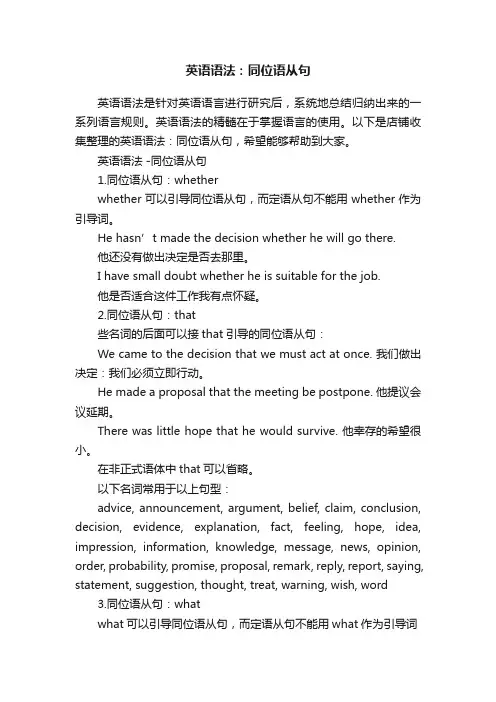
英语语法:同位语从句英语语法是针对英语语言进行研究后,系统地总结归纳出来的一系列语言规则。
英语语法的精髓在于掌握语言的使用。
以下是店铺收集整理的英语语法:同位语从句,希望能够帮助到大家。
英语语法 -同位语从句1.同位语从句:whetherwhether可以引导同位语从句,而定语从句不能用whether作为引导词。
He hasn’t made the decision whether he will go there.他还没有做出决定是否去那里。
I have small doubt whether he is suitable for the job.他是否适合这件工作我有点怀疑。
2.同位语从句:that些名词的后面可以接that引导的同位语从句:We came to the decision that we must act at once. 我们做出决定:我们必须立即行动。
He made a proposal that the meeting be postpone. 他提议会议延期。
There was little hope that he would survive. 他幸存的希望很小。
在非正式语体中that可以省略。
以下名词常用于以上句型:advice, announcement, argument, belief, claim, conclusion, decision, evidence, explanation, fact, feeling, hope, idea, impression, information, knowledge, message, news, opinion, order, probability, promise, proposal, remark, reply, report, saying, statement, suggestion, thought, treat, warning, wish, word3.同位语从句:whatwhat可以引导同位语从句,而定语从句不能用what作为引导词I have no idea what he is doing now. 我不知道他现在在干什么。
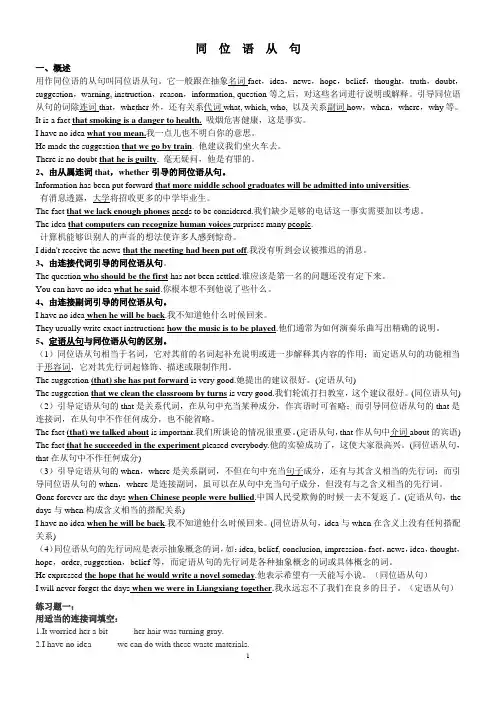
同位语从句一、概述用作同位语的从句叫同位语从句。
它一般跟在抽象名词fact,idea,news,hope,belief,thought,truth,doubt,suggestion,warning, instruction,reason,information, question等之后,对这些名词进行说明或解释。
引导同位语从句的词除连词that,whether外,还有关系代词what, which, who, 以及关系副词how,when,where,why等。
It is a fact that smoking is a danger to health.吸烟危害健康,这是事实。
I have no idea what you mean.我一点儿也不明白你的意思。
He made the suggestion that we go by train. 他建议我们坐火车去。
There is no doubt that he is guilty. 毫无疑问,他是有罪的。
2、由从属连词that,whether引导的同位语从句。
Information has been put forward that more middle school graduates will be admitted into universities.有消息透露,大学将招收更多的中学毕业生。
The fact that we lack enough phones needs to be considered.我们缺少足够的电话这一事实需要加以考虑。
The idea that computers can recognize human voices surprises many people.计算机能够识别人的声音的想法使许多人感到惊奇。
I didn't receive the news that the meeting had been put off.我没有听到会议被推迟的消息。
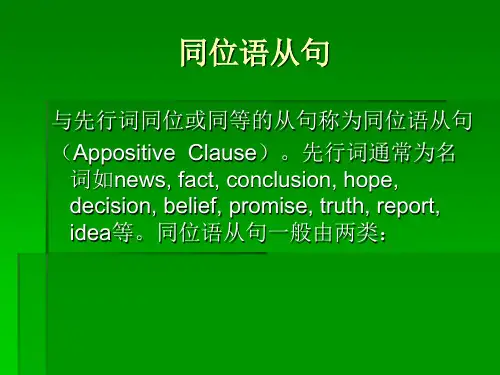
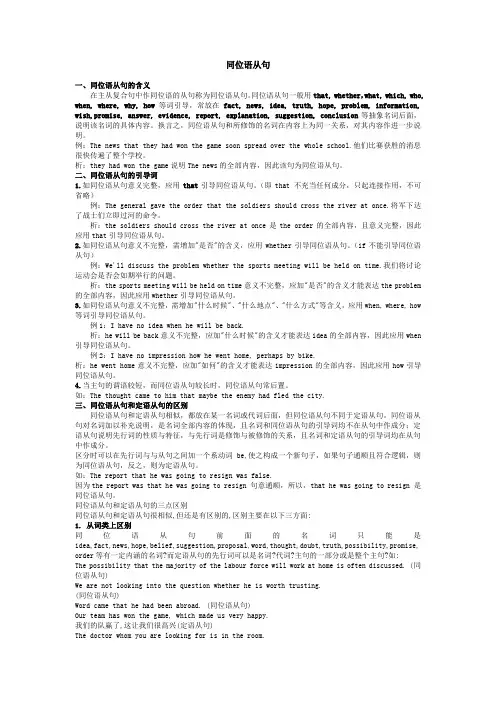
同位语从句一、同位语从句的含义在主从复合句中作同位语的从句称为同位语从句。
同位语从句一般用that, whether,what, which, who, when, where, why, how 等词引导,常放在fact, news, idea, truth, hope, problem, information, wish,promise, answer, evidence, report, explanation, suggestion, conclusion等抽象名词后面,说明该名词的具体内容。
换言之,同位语从句和所修饰的名词在内容上为同一关系,对其内容作进一步说明。
例:The news that they had won the game soon spread over the whole school.他们比赛获胜的消息很快传遍了整个学校。
析:they had won the game说明The news的全部内容,因此该句为同位语从句。
二、同位语从句的引导词1.如同位语从句意义完整,应用that引导同位语从句。
(即that 不充当任何成分,只起连接作用,不可省略)例:The general gave the order that the soldiers should cross the river at once.将军下达了战士们立即过河的命令。
析:the soldiers should cross the river at once是the order的全部内容,且意义完整,因此应用that引导同位语从句。
2.如同位语从句意义不完整,需增加"是否"的含义,应用whether引导同位语从句。
(if不能引导同位语从句)例:We'll discuss the problem whether the sports meeting will be held on time.我们将讨论运动会是否会如期举行的问题。


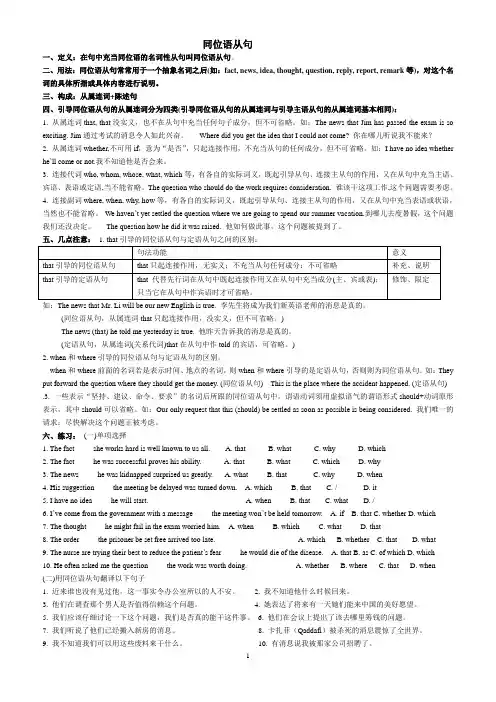
同位语从句一、定义:在句中充当同位语的名词性从句叫同位语从句。
二、用法:同位语从句常常用于一个抽象名词之后(如:fact, news, idea, thought, question, reply, report, remark等),对这个名词的具体所指或具体内容进行说明。
三、构成:从属连词+陈述句四、引导同位语从句的从属连词分为四类(引导同位语从句的从属连词与引导主语从句的从属连词基本相同):1. 从属连词that, that没实义,也不在从句中充当任何句子成分,但不可省略。
如:The news that Jim has passed the exam is so exciting. Jim通过考试的消息令人如此兴奋。
Where did you get the idea that I could not come? 你在哪儿听说我不能来?2. 从属连词whether,不可用if,意为“是否”,只起连接作用,不充当从句的任何成分,但不可省略。
如:I have no idea whether he’ll come or not.我不知道他是否会来。
3. 连接代词who, whom, whose, what, which等,有各自的实际词义,既起引导从句、连接主从句的作用,又在从句中充当主语、宾语、表语或定语,当不能省略。
The question who should do the work requires consideration. 谁该干这项工作,这个问题需要考虑。
4. 连接副词where, when, why, how等,有各自的实际词义,既起引导从句、连接主从句的作用,又在从句中充当表语或状语,当然也不能省略。
We haven’t yet settled the question where we are going to spend our summer vacation.到哪儿去度暑假,这个问题我们还没决定。
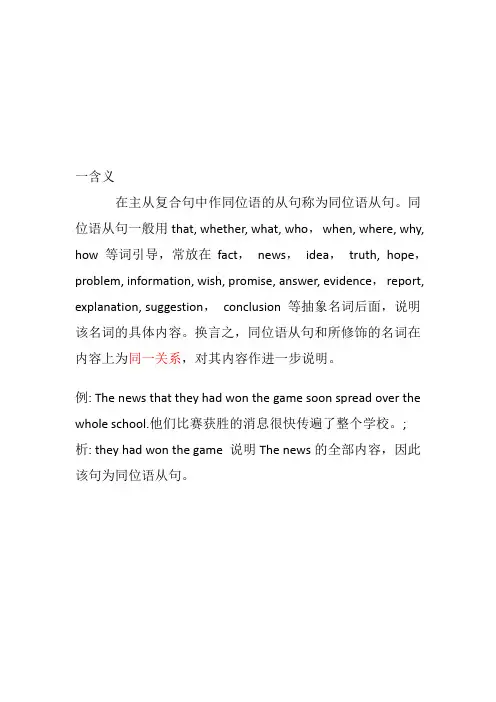
一含义在主从复合句中作同位语的从句称为同位语从句。
同位语从句一般用that, whether, what, who,when, where, why, how 等词引导,常放在fact,news,idea,truth, hope,problem, information, wish, promise, answer, evidence,report, explanation, suggestion,conclusion 等抽象名词后面,说明该名词的具体内容。
换言之,同位语从句和所修饰的名词在内容上为同一关系,对其内容作进一步说明。
例: The news that they had won the game soon spread over the whole school.他们比赛获胜的消息很快传遍了整个学校。
; 析: they had won the game 说明The news的全部内容,因此该句为同位语从句。
1.名词作同位语Mr Wang, my child’s teacher, will be visiting us on Tuesday.王先生,我孩子的老师,星期二要来看我们。
(在这里'my child's teacher'做同位语修饰'Mr Wang')2.短语作同位语I, the oldest girl in the family, always had to care for the other children.我,作为家里最大的女孩,总是要照料家中的其他孩子。
3.直接引语作同位语But now the question comes to their minds,“Did she die young because she was a clone?”但是现在他们不得不思考这样的问题:“多莉早死是因为它是一只克隆羊吗?”4.句子作同位语The girls were surprised at the fact that ocean ships can sail up the Great lakes.巨大的海轮可以开到五大湖,让表姐妹俩感到吃惊。
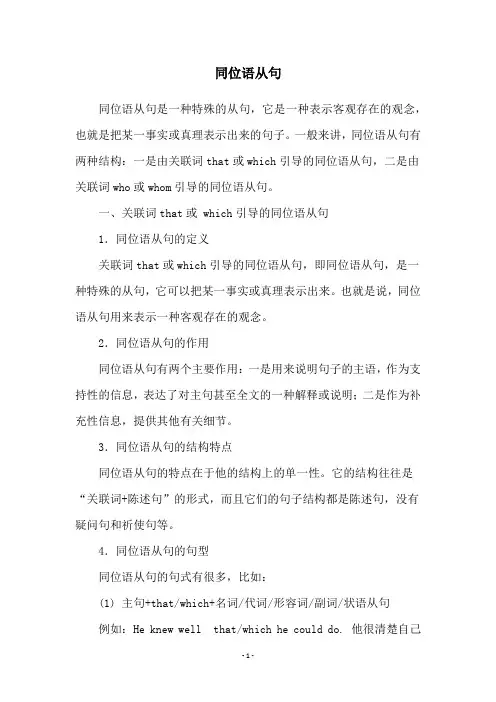
同位语从句同位语从句是一种特殊的从句,它是一种表示客观存在的观念,也就是把某一事实或真理表示出来的句子。
一般来讲,同位语从句有两种结构:一是由关联词that或which引导的同位语从句,二是由关联词who或whom引导的同位语从句。
一、关联词that或 which引导的同位语从句1.同位语从句的定义关联词that或which引导的同位语从句,即同位语从句,是一种特殊的从句,它可以把某一事实或真理表示出来。
也就是说,同位语从句用来表示一种客观存在的观念。
2.同位语从句的作用同位语从句有两个主要作用:一是用来说明句子的主语,作为支持性的信息,表达了对主句甚至全文的一种解释或说明;二是作为补充性信息,提供其他有关细节。
3.同位语从句的结构特点同位语从句的特点在于他的结构上的单一性。
它的结构往往是“关联词+陈述句”的形式,而且它们的句子结构都是陈述句,没有疑问句和祈使句等。
4.同位语从句的句型同位语从句的句式有很多,比如:(1) 主句+that/which+名词/代词/形容词/副词/状语从句例如:He knew well that/which he could do. 他很清楚自己能做什么。
(2) 主句+that/which+从句例如:It is clear that/which they are wrong. 他们是错的这一点很清楚。
二、关联词who或whom引导的同位语从句1.同位语从句的定义关联词who或whom引导的同位语从句,也就是同位语从句,是一种特殊的从句,它表示客观存在的观念,也就是把某一事实或真理表示出来的句子。
2.同位语从句的作用相对于that或which引导的同位语从句而言,who或whom引导的同位语从句主要用于引出人物或实体,对一句话中的人物或事物有更深入的认识和说明。
3.同位语从句的结构特点同位语从句的特点在于它的句子结构是陈述句,没有疑问句和祈使句等,而它们的结构往往是“关联词+陈述句”的形式。
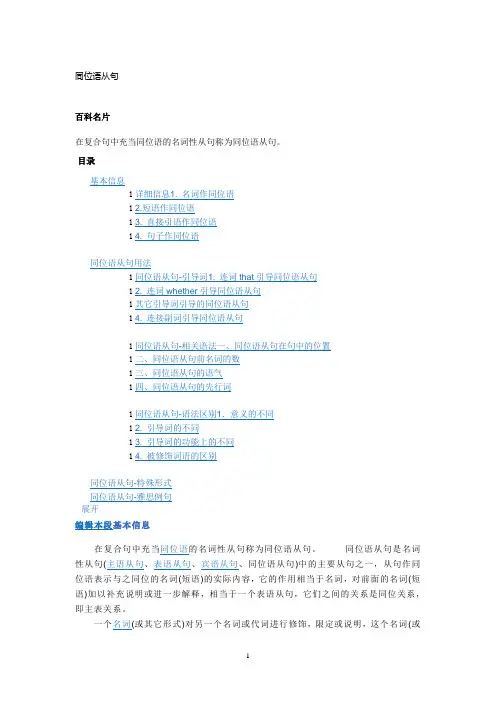
同位语从句百科名片在复合句中充当同位语的名词性从句称为同位语从句。
目录基本信息1详细信息1. 名词作同位语12.短语作同位语13. 直接引语作同位语14. 句子作同位语同位语从句用法1同位语从句-引导词1. 连词that引导同位语从句12. 连词whether引导同位语从句1其它引导词引导的同位语从句14. 连接副词引导同位语从句1同位语从句-相关语法一、同位语从句在句中的位置1二、同位语从句前名词的数1三、同位语从句的语气1四、同位语从句的先行词1同位语从句-语法区别1.意义的不同12. 引导词的不同13. 引导词的功能上的不同14. 被修饰词语的区别同位语从句-特殊形式同位语从句-雅思例句展开编辑本段基本信息在复合句中充当同位语的名词性从句称为同位语从句。
同位语从句是名词性从句(主语从句、表语从句、宾语从句、同位语从句)中的主要从句之一,从句作同位语表示与之同位的名词(短语)的实际内容,它的作用相当于名词,对前面的名词(短语)加以补充说明或进一步解释,相当于一个表语从句,它们之间的关系是同位关系,即主表关系。
一个名词(或其它形式)对另一个名词或代词进行修饰,限定或说明,这个名词(或其它形式)就是同位语。
同位语与被它限定的词的格要一致,并常常紧挨在一起。
1. 名词作同位语Mr Wang, my child’s teacher, will be visiting us on Tuesday.王先生,我孩子的老师,星期二要来看我们。
2.短语作同位语I, the oldest girl in the family, always had to care for the other children.我,作为家里最大的女孩,老得照料家中的其他孩子。
3. 直接引语作同位语But now the question comes to their minds, “Did she die young because she was a clone?”但是现在他们不得不思考这样的问题:“多莉早死是因为它是一只克隆羊吗?”4. 句子作同位语The girls were surprised at the fact that ocean ships can sail up the Great lakes.巨大的海轮可以开到五大湖,让表姐妹俩感到吃惊。
同位语从句(Appositive Clauses)一、概念1. 同位语:紧跟在名词或代词之后,用于说明该名词或代词是何人、何物的词语叫做同位语。
We Chinese love our country. 我们中国人热爱我们的祖国。
主语同位语I, the youngest son in the family, am often taken good care of.作为年纪最小的儿子的我经常受到最好的照顾。
This word, dyeing, is often misspelled. Dyeing这个单词经常被拼错。
【活学活用】①我们学生应该努力学习。
__________________________should work hard.②这是我的名字,Tony。
This is __________,_____________.2. 同位语从句:在主从复合句中作同位语的从句称为同位语从句。
We came to the decision that we must act at once. 我们做出决定:我们必须立即行动。
中心词引导词(同位语)从句I have small doubt whether he is suitable for the job. 他是否适合这件工作我有点怀疑。
中心词引导词(同位语)从句★同位语从句结构:中心词+ 引导词+(同位语)从句二. 同位语从句的功能及引导词1. 同位语从句对于名词进一步解释,说明名词的具体内容,置于某些抽象名词之后。
换言之,同位语从句和所修饰的名词在内容上为同一关系,对其内容作进一步说明。
常见的名词有:fact(事实),idea(想法),news(新闻),belief(信念),message(信息),proposal (建议),proposition(建议),evidence(证据),proof(证据),possibility(可能性),suggestion (建议)等。
完整版)同位语从句是同位语从句?同位语从句是在主从复合句中作同位语的从句。
它通常放在抽象名词后面,如fact、news、idea、truth、hope、problem、n、wish、promise、answer、evidence、report、n、n、n等,用来说明该名词的具体内容。
同位语从句和所修饰的名词在内容上为同一关系,对其内容作进一步说明。
例如,句子“The news that they had won the game soon spread over the whole school.”中,“they had won the game”说明了“The news”的全部内容,因此该句为同位语从句。
同位语从句的引导词有哪些?同位语从句一般用that、whether、what、which、who、when、where、why、how等词引导。
其中,that只起连接作用,不充当任何成分,不可省略。
而whether、what、how虽然不能引导定语从句,但可以用在同位语从句中。
例如,句子“We'll discuss the problem whether the sports m eeting will be held on time.”中,“whether”引导了同位语从句,增加了“是否”的含义,表达了“the problem”的全部内容。
另外,引导词还要根据从句的意义进行选择,如增加“什么”、“谁”、“什么时候”、“什么地点”、“什么方式”等含义。
例如,句子“I have no idea what he is doing now.”中,“what”引导了同位语从句,增加了“什么”的含义,表达了“I”对于“he is doing”的不了解。
句子“The n who should d o the work requires XXX.”中,“who”引导了同位语从句,增加了“谁”的含义,表达了“the n”的全部内容。
同位语从句和定语从句区别例句1. 同位语从句:他有个梦想,那就是成为超级英雄拯救世界。
(“成为超级英雄拯救世界”就是对“梦想”的同位解释,直接等同)定语从句:他有个梦想,这个梦想像一颗遥远的星星,难以触及的那种,就是成为超级英雄拯救世界。
(“这个梦想”是先行词,后面的句子修饰它,像描述星星一样形容这个梦想)2. 同位语从句:我听到一个消息,我们明天不用上班啦。
(消息就是明天不用上班这件事本身)定语从句:我听到一个消息,这个消息像一阵突如其来的春风,就是我们明天不用上班啦。
(消息作为先行词,后面句子修饰它,把消息比喻成春风)3. 同位语从句:她有个想法,她要去月亮上种土豆。
(想法就是去月亮种土豆这件事)定语从句:她有个想法,这个想法像一个超级疯狂的冒险旅程,就是她要去月亮上种土豆。
(想法是先行词,后面句子修饰,把想法形容成冒险旅程)4. 同位语从句:他得到一个命令,马上停止手头的工作。
(命令就是马上停止工作这件事)定语从句:他得到一个命令,这个命令像一道紧急的闪电,那就是马上停止手头的工作。
(命令是先行词,后面句子修饰,把命令比作闪电)5. 同位语从句:我们有个约定,十年后再相见。
(约定就是十年后相见这件事)定语从句:我们有个约定,这个约定像一个漫长的等待游戏,就是十年后再相见。
(约定为先行词,后面句子修饰,把约定比喻成等待游戏)6. 同位语从句:他有个信念,他一定能成为百万富翁。
(信念就是能成为百万富翁这件事)定语从句:他有个信念,这个信念像一团永不熄灭的火焰,就是他一定能成为百万富翁。
(信念是先行词,后面句子修饰,把信念比作火焰)7. 同位语从句:我有个计划,暑假去北极看企鹅。
(计划就是暑假去北极看企鹅这件蠢事,当然北极没有企鹅啦,这是个玩笑,强调是计划本身)定语从句:我有个计划,这个计划像一个异想天开的童话,就是暑假去北极看企鹅。
(计划是先行词,后面句子修饰,把计划形容成童话)8. 同位语从句:她有个愿望,拥有一双能飞的翅膀。
同位语从句1.什么是同位语从句在主从复合句中作同位语的从句称为同位语从句,常放在fact, news, idea, truth, hope, problem, information, wish,promise, answer, evidence, report, explanation, suggestion, conclusion等抽象名词后面,说明该名词的具体内容。
换言之,同位语从句和所修饰的名词在内容上为同一关系,对其内容作进一步说明。
例:The news that they had won the game soon spread over the whole school.他们比赛获胜的消息很快传遍了整个学校。
析:they had won the game说明The news的全部内容,因此该句为同位语从句。
2.引导词有哪些怎么用同位语从句一般用that, whether,what, which, who, when, where, why, how等词引导。
(补充:whether, what, how 不能引导定语从句,但可以用在同位语从句)补充:when,where 和why 引导的定语从句和同位语从句之区别:when , where 和why 作关系副词引导定语从句时,有跟它们含义相应的先行词,且先行词在从句中充当一定成分。
当when , where 和why作连接副词引导同位语从句时,则没有与它们含义相应的先行词。
所以,只要看先行词就可以判定了,若先行词和引导词关系密切,就是定从;只是修饰关系,就是同位语从句。
试比较:I'll never forget the day when ( = on which ) we met for the fir st time . ( 定语从句)I have no idea when we met for the first time ( 同位语从句)The office where ( = in which ) you work is here . ( 定语从句)Then arose the question where we were to get so much money . ( 同位语从句)The reason why ( = for which ) he did not come is quite clear . ( 定语从句)Xiao Wang has solved the problem why the TV was out of order . ( 同位语从句)以上例句中when , where 和why 作关系副词引导定语从句时,可以改为“介词+ 关系代词which”来引导;而引导同位语从句的when , where 和why 就不能这样改。